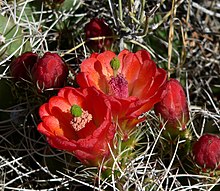Echinocereus
| Echinocereus | |
|---|---|

| |
| Echinocereus triglochidiatus | |
| Scientific classification | |
| Kingdom: | |
| (unranked): | |
| (unranked): | |
| (unranked): | |
| Order: | |
| Family: | |
| Subfamily: | |
| Tribe: | |
| Subtribe: | Echinocereinae
|
| Genus: | Echinocereus |
| Species | |
|
See text | |
| Synonyms | |
|
Morangaya G.D.Rowley | |
Echinocereus is a genus of ribbed, usually small to medium-sized, cylindrical cacti, comprising about 70 species native to the southern United States and Mexico in very sunny, rocky places. Usually the flowers are large and the fruit edible.
The name comes from the Ancient Greek ἐχῖνος (echinos), meaning "hedgehog", and the Latin cereus meaning "candle". They are sometimes known as hedgehog cacti,[2] a term also used for the Pediocactus and Echinopsis.[3]
Description
Echinocereus spp. are bushy and globular with tight spines, which are often colorful and decorative. The flowers last slightly longer than those of other cacti.[citation needed]
Cultivation
Echinocereus spp. are easier to cultivate than many other cacti.[citation needed] They need light soil, a sunny exposure, and a fresh and dry winter to flower. They grow better in soil slightly richer than other cacti. In the wild, several of the species are cold hardy, tolerating temperatures as low as -23°C, but only in dry conditions.
Species






The following species are recognised in the genus Echinocereus:[2]
- Echinocereus acifer (Otto ex Salm-Dyck) Lem.
- Echinocereus adustus Engelm.
- Echinocereus apachensis W. Blum & Rutow
- Echinocereus arizonicus Rose ex Orcutt
- Echinocereus barthelowanus Britton & Rose
- Echinocereus berlandieri (Engelm.) Haage f.
- Echinocereus bonkerae Thornber & Bonker
- Echinocereus brandegeei (J.M. Coult.) K. Schum.
- Echinocereus bristolii W.T. Marshall
- Echinocereus chisoensis W.T.Marshall
- Echinocereus cinerascens (DC.) H.P. Kelsey & Dayton
- Echinocereus coccineus Engelm.
- Echinocereus dasyacanthus Engelm.
- Echinocereus davisii Houghton
- Echinocereus engelmannii (Parry ex Engelm.) Lem.
- Echinocereus enneacanthus Engelm.
- Echinocereus fasciculatus (Engelm. ex B.D.Jacks.) L.D.Benson
- Echinocereus fendleri (Engelm.) Sencke ex J.N.Haage
- Echinocereus ferreirianus H.E.Gates
- Echinocereus freudenbergii G. Frank
- Echinocereus grandis Britton & Rose
- Echinocereus klapperi W. Blum
- Echinocereus knippelianus Liebm.
- Echinocereus laui G. Frank
- Echinocereus ledingii Peebles
- Echinocereus leucanthus N.P. Taylor
- Echinocereus longisetus (Engelm.) Rümpler
- Echinocereus mapimiensis E.F. Anderson, W.C. Hodgs. & P. Quirk
- Echinocereus maritimus (M.E. Jones) K. Schum.
- Echinocereus metornii G. Frank
- Echinocereus mombergerianus G. Frank
- Echinocereus nicholii (L.Benson) Parfitt
- Echinocereus nivosus Glass & R.A. Foster
- Echinocereus ortegae Rose
- Echinocereus pacificus (Engelm. ex Orcutt) Britton & Rose
- Echinocereus palmeri Britton & Rose
- Echinocereus pamanesiorum A.B. Lau
- Echinocereus papillosus Linke ex Rumpl.
- Echinocereus parkeri N.P. Taylor
- Echinocereus pectinatus (Scheidw.) Engelm.
- Echinocereus pensilis (K. Brandegee) J.A. Purpus
- Echinocereus pentalophus (DC.) Haage
- Echinocereus polyacanthus Engelm.
- Echinocereus poselgeri Lem.
- Echinocereus primolanatus N.P. Taylor
- Echinocereus pseudopectinatus (N.P. Taylor) N.P. Taylor
- Echinocereus pulchellus (Mart.) Seitz
- Echinocereus rayonesensis N.P. Taylor
- Echinocereus reichenbachii (Terscheck ex Walp.) hort. ex Haage
- Echinocereus rigidissimus (Engelm.) hort. ex F.Haage
- Echinocereus ×roetteri (Engelm.) Engelm. ex Rümpler
- Echinocereus russanthus D. Weniger
- Echinocereus salm-dyckianus Scheer
- Echinocereus santaritensis W. Blum & Rutow
- Echinocereus scheeri (Salm-Dyck) Scheer
- Echinocereus scheerii G. Frank
- Echinocereus schmollii (Weing.) N.P.Taylor
- Echinocereus sciurus (K. Brandegee) Dams
- Echinocereus scopulorum Britton & Rose
- Echinocereus spinigemmatus A.B. Lau
- Echinocereus stoloniferus W.T. Marshall
- Echinocereus stramineus (Engelm.) F.Seitz
- Echinocereus subinermis Salm-Dyck ex Scheer
- Echinocereus triglochidiatus Engelm. – King Cup Cactus, Claret Cup Cactus
- Echinocereus viereckii Werderm.
- Echinocereus viridiflorus Engelm. – Green Pitaya
- Echinocereus websterianus G.E. Linds.
Formerly placed here
- Echinopsis candicans (Gillies ex Salm-Dyck) F.A.C.Weber ex D.R.Hunt (as E. candicans (Gillies ex Salm-Dyck) Rümpler)[4]
References
- ^ a b "Genus: Echinocereus Engelm". Germplasm Resources Information Network. United States Department of Agriculture. 2004-02-13. Archived from the original on 2012-10-11. Retrieved 2011-04-10.
- ^ a b "Echinocereus". Integrated Taxonomic Information System. Retrieved 2011-04-10.
- ^ "Echinopsis (Hedgehog Cacti)". Cactus and Succulent Society of Australia. Archived from the original on 2008-07-20. Retrieved 2008-07-29.
- ^ "GRIN Species Records of Echinocereus". Germplasm Resources Information Network. United States Department of Agriculture. Archived from the original on 2015-09-24. Retrieved 2011-04-10.
Further reading
- Fischer, Pierre C. 70 Common Cacti of the Southwest. City unknown: Southwest Parks and Monuments Association, 1989.
- Anderson, Miles (1998). The Ultimate Book of Cacti and Succulents. ISBN 1-85967-460-7. Lorenz Books.
- Innes C, Wall B (1995). Cacti' Succulents and Bromaliads. Cassell & The Royal Horticultural Society.
- Anderson, Edward F. : "The Cactus Family" (2001)
- Taylor, Nigel P.: The Genus Echinocereus. Kew Magazine Monograph, Timber Press 1985, ISBN 0-88192-052-5
- Blum, Lange, Rischer & Rutow: Echinocereus, (1998)
External links
- Echinocereus on CactiGuide.com
- Echinocereus Online (in German)
- USDA PLANTS Profile
- "Black Lace Cactus (Echinocereus reichenbachii var. albertii)". Endangered and Threatened Species. Texas Parks and Wildlife Department.
